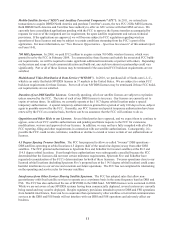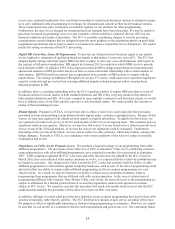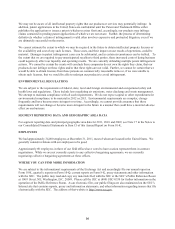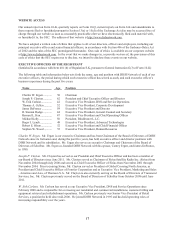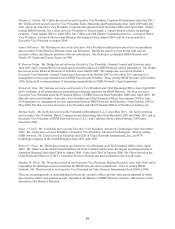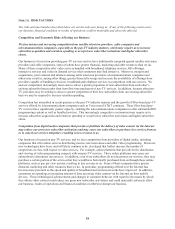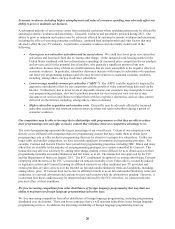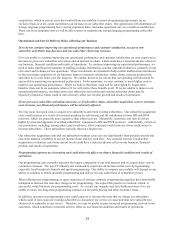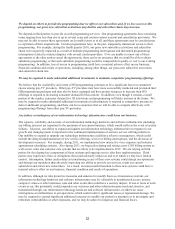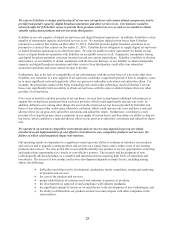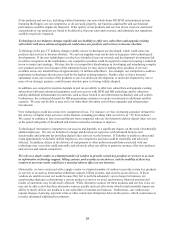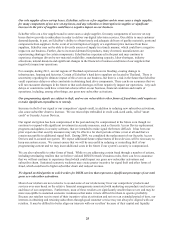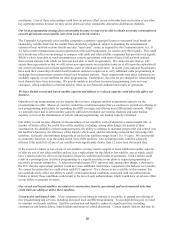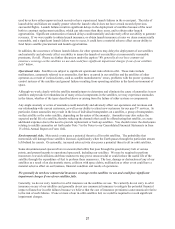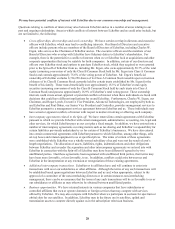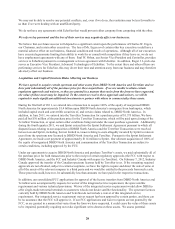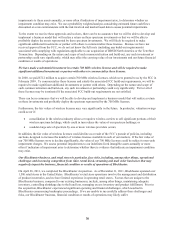Dish Network 2011 Annual Report Download - page 30
Download and view the complete annual report
Please find page 30 of the 2011 Dish Network annual report below. You can navigate through the pages in the report by either clicking on the pages listed below, or by using the keyword search tool below to find specific information within the annual report.20
20
Economic weakness, including higher unemployment and reduced consumer spending, may adversely affect our
ability to grow or maintain our business.
A substantial majority of our revenue comes from residential customers whose spending patterns may be affected by
sustained economic weakness and uncertainty. Economic weakness and uncertainty persisted during 2011. Our
ability to grow or maintain our business may be adversely affected by sustained economic weakness and uncertainty,
including the effect of wavering consumer confidence, continued high unemployment and other factors that may
adversely affect the pay-TV industry. In particular, economic weakness and uncertainty could result in the
following:
x Fewer gross new subscriber activations and increased churn. We could face fewer gross new subscriber
activations and increased churn due to, among other things: (i) the sustained weak housing market in the
United States combined with lower discretionary spending; (ii) increased price competition for our products
and services; and (iii) the potential loss of retailers, who generate a significant portion of our new
subscribers, because many of them are small businesses that are more susceptible to the negative effects of
economic weakness. In particular, subscriber churn may increase with respect to subscribers who purchase
our lower tier programming packages and who may be more sensitive to sustained economic weakness,
including, among others, our pay-in-advance subscribers.
x Lower average monthly revenue per subscriber (“ARPU”). Our ARPU could be negatively impacted by
aggressive introductory offers by our competitors and the growth of video content being delivered via the
Internet. Furthermore, due to lower levels of disposable income, our customers may downgrade to lower
cost programming packages, elect not to purchase premium services or pay per view movies or may
disconnect our services and choose to replace them with less expensive alternatives such as video content
delivered via the Internet, including, among others, video on demand.
x Higher subscriber acquisition and retention costs. Our profits may be adversely affected by increased
subscriber acquisition and retention costs necessary to attract and retain subscribers during a period of
economic weakness.
Our competitors may be able to leverage their relationships with programmers so that they are able to reduce
their programming costs and offer exclusive content that will place them at a competitive advantage to us.
The cost of programming represents the largest percentage of our overall costs. Certain of our competitors own
directly or are affiliated with companies that own programming content that may enable them to obtain lower
programming costs or offer exclusive programming that may be attractive to prospective subscribers. Unlike our
larger cable and satellite competitors, we have not made significant investments in programming providers. For
example, Comcast and General Electric have joined their programming properties, including NBC, Bravo and many
others that are available in the majority of our programming packages, in a venture controlled by Comcast. This
transaction may affect us adversely by, among other things, making it more difficult for us to obtain access to their
programming networks on nondiscriminatory and fair terms, or at all. The transaction was approved by the FCC
and the Department of Justice in January 2011. The FCC conditioned its approval on, among other things, Comcast
complying with the terms of the FCC’s recent order on network neutrality (even if that order is vacated by judicial
or legislative action) and Comcast licensing its affiliated content to us, other traditional pay-TV providers and
certain providers of video services over the Internet on fair and nondiscriminatory terms and conditions, including,
among others, price. If Comcast does not license its affiliated content to us on fair and nondiscriminatory terms and
conditions, we can seek arbitration and continue to carry such content while the arbitration is pending. However, it
is uncertain how these conditions may be interpreted and enforced by the FCC; therefore, we cannot predict the
practical effect of these conditions.
We face increasing competition from other distributors of foreign language programming that may limit our
ability to maintain our foreign language programming subscriber base.
We face increasing competition from other distributors of foreign language programming, including programming
distributed over the Internet. There can be no assurance that we will maintain subscribers in our foreign language
programming services. In addition, the increasing availability of foreign language programming from our



